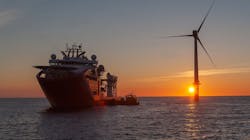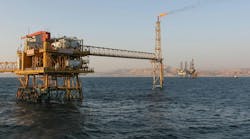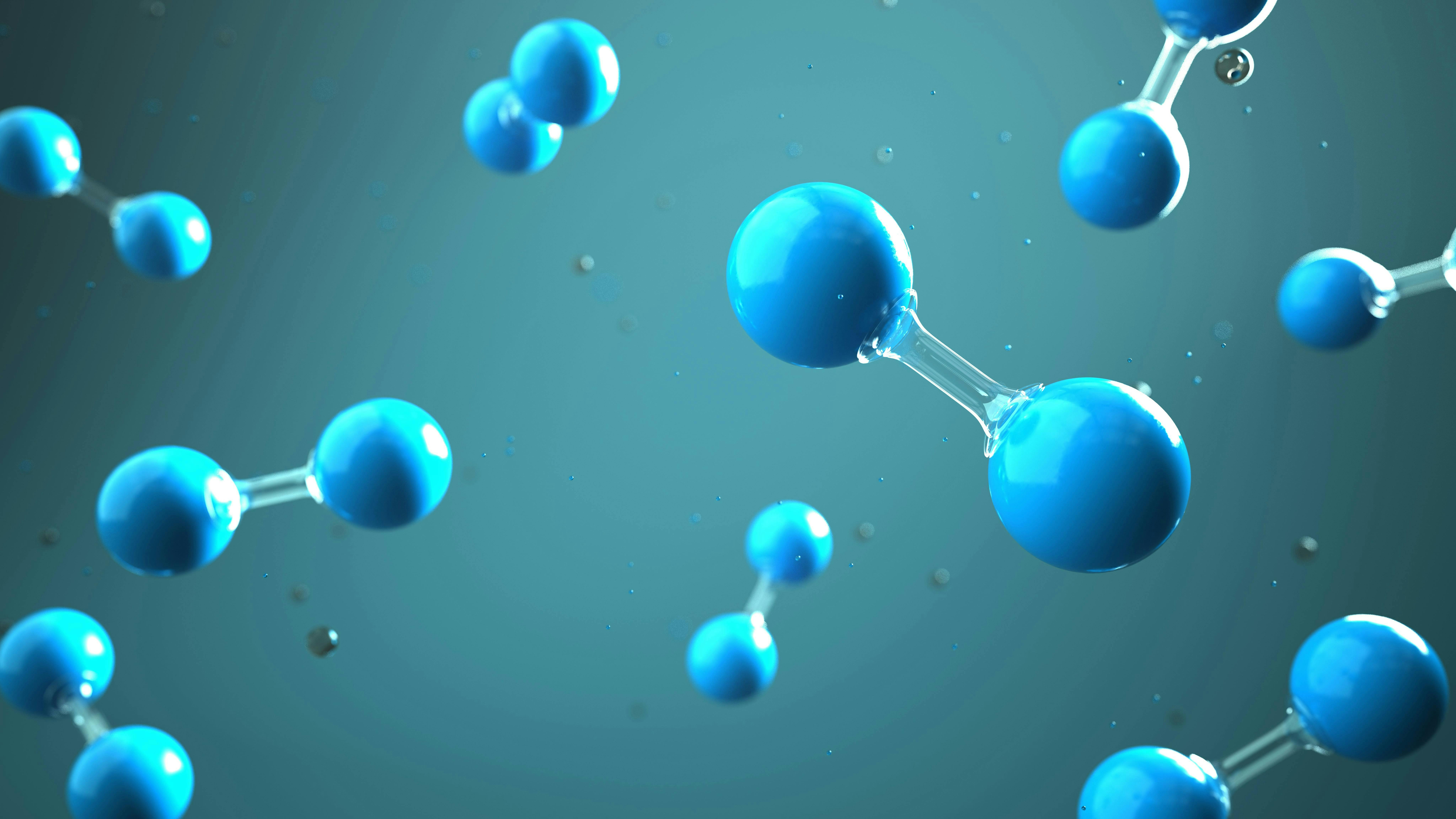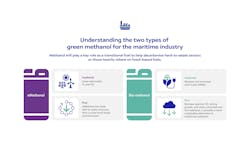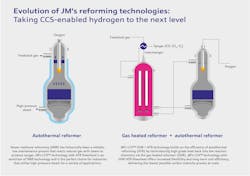ADIPEC 2025: Johnson Matthey executive discusses offshore decarbonization challenges
Key Highlights
- Blue hydrogen is a scalable, near-term solution leveraging existing gas infrastructure, while green hydrogen from offshore wind offers zero-carbon potential for future offshore energy systems.
- Emerging fuels like biomethanol and e-methanol are practical for offshore operations, offering compatibility with existing engines and circular carbon benefits.
- Collaboration among technology providers, regulators and financiers accelerates project development, enhances bankability and ensures compliance with evolving environmental standards.
By Ariana Hurtado, Editor-in-Chief
As the offshore energy sector navigates the complexities of the global energy transformation, technologies that enable practical, scalable decarbonization are gaining momentum.
Ahead of next month's ADIPEC Conference and Exhibition, Offshore chatted with one of the show's speakers, Maurits van Tol, chief executive of catalyst technologies at Johnson Matthey, to discuss the company’s approach to supporting both offshore oil and gas and renewables.
In this exclusive Q&A, van Tol shares insights on the evolving roles of hydrogen, methanol and ammonia in offshore operations, the viability of low-carbon fuels, and the policy and infrastructure shifts needed to accelerate progress toward net-zero goals.
Offshore: How is Johnson Matthey aligning its strategy to support offshore oil and gas and offshore renewables in the energy transition?
van Tol: At Johnson Matthey, we recognize that the energy transition must be practical as well as ambitious. For offshore operators, this means decarbonizing existing assets rather than completely replacing hydrocarbon infrastructure. Our strategy is built around enabling that transition, supporting customers to continue monetizing natural gas resources while lowering their emissions through blue hydrogen, carbon capture and storage (CCS) integration, and low-carbon fuel technologies.
Our LCH technology, for example, allows offshore producers to convert natural gas into hydrogen with up to 99% of the CO2 captured and stored. This creates blue hydrogen that has an exceptionally low carbon intensity, while using the same geological formations that once held hydrocarbons to now store captured CO2. It is a powerful example of how upstream oil and gas expertise can be repurposed for the low-carbon economy.
Beyond hydrocarbons, we are also exploring synergies between blue hydrogen and offshore renewables, particularly wind-powered electrolysis. Hybrid offshore energy hubs combining hydrogen, methanol and ammonia production will play an increasingly important role in achieving decarbonization at scale.
Offshore: Can you elaborate on the company's CLEANPACE retrofit technology and its potential to decarbonize offshore hydrogen and methanol production assets?
van Tol: CLEANPACE technology is a suite of ready-now retrofit solutions that can reduce CO2 emissions from existing grey hydrogen and methanol plants by up to 95%. It combines Johnson Matthey’s LCH technology with pre-combustion carbon capture to deliver a low-carbon production route without requiring full asset replacement. Designed specifically for brownfield sites, it offers low upfront capital cost, minimal plot space requirements and limited disruption to ongoing operations.
CLEANPACE is particularly well suited to offshore environments where space, weight and power are constrained, and where building new facilities is impractical. It enables operators to decarbonize assets that are still within their depreciation cycle, helping maintain production while meeting stricter emissions expectations.
While CLEANPACE is aimed at brownfield applications, Johnson Matthey’s LCH technology serves as the solution for new or greenfield developments. Together they form a comprehensive low-carbon platform for hydrogen, ammonia and methanol production that complements offshore CO2 transport and storage systems.
Offshore: What role do you see for blue and green hydrogen in offshore energy systems, particularly in regions like the Gulf of Mexico or North Sea?
van Tol: Hydrogen will be fundamental to the decarbonization of offshore energy systems, with both blue and green hydrogen playing complementary roles. Blue hydrogen represents the most scalable near-term solution for offshore applications, leveraging existing natural gas resources and the availability of geological CO2 storage in mature basins, such as the North Sea and Gulf of Mexico. By integrating reforming technologies with CCS, offshore producers can significantly reduce their emissions while continuing to operate core gas assets.
In the longer term, green hydrogen will become increasingly important as offshore wind capacity expands and renewable electricity becomes more abundant. Producing hydrogen through electrolysis directly powered by offshore wind farms will enable entirely zero-carbon energy systems, particularly in regions with strong renewable potential.
Both forms of hydrogen have critical applications offshore. They can be used to power platforms, replace diesel in generators and support vessels, or serve as feedstock for producing low-carbon methanol and ammonia. These fuels can then be exported to shore or used to store and transport energy.
Offshore: Johnson Matthey is involved in biomethanol and e-methanol projects. How viable are these fuels for offshore energy operations?
van Tol: Biomethanol and e-methanol represent highly promising low-carbon fuels for offshore and marine energy operations, particularly as transitional solutions that bridge the gap between conventional hydrocarbons and full electrification. Their key advantage is compatibility. Both fuels can be used in most existing marine and offshore engines with minimal modifications, making them a practical and cost-effective option for operators seeking to decarbonize without the need for major equipment replacement.
In addition to their ease of use, methanol-based fuels are easier to store and transport than compressed hydrogen, offering higher volumetric energy density and liquid-phase handling under ambient conditions. This makes them particularly suitable for long-distance offshore applications such as floating production storage and offloading units (FPSOs), support vessels and supply ships, where space, weight and refueling logistics are critical factors.
From a sustainability perspective, both biomethanol and e-methanol can be produced from biogenic or captured CO2 combined with green hydrogen derived from renewable electricity. This creates a circular carbon pathway, allowing operators to recycle emissions into new fuel rather than releasing them to the atmosphere.
The main challenges today lie in production cost, global fuel availability and the scaling of supply chains to meet commercial demand. However, as carbon pricing strengthens and renewable hydrogen capacity grows, these fuels are expected to become increasingly competitive. With Johnson Matthey’s expertise in methanol synthesis and catalytic process efficiency, the company is helping to advance these technologies towards wider adoption in offshore operations, supporting a smoother and more achievable energy transition.
Offshore: What are the biggest policy gaps or technical bottlenecks preventing faster adoption of low-carbon technologies offshore?
van Tol: While progress in offshore decarbonization has been significant, several barriers continue to slow wider adoption. One of the biggest challenges is the lack of clarity around CO2 storage liability and long-term regulatory frameworks. Operators and investors need assurance that captured CO2 can be stored securely and that responsibility for monitoring and verification is clearly defined. Greater regulatory certainty in this area would help unlock large-scale investment in blue hydrogen, and CCS projects.
Infrastructure limitations also pose a bottleneck. Many offshore regions lack the pipeline and transport capacity required for moving both hydrogen and captured CO2 between platforms and shore-based hubs. Developing this shared infrastructure is essential to enable networked decarbonization at scale.
From a technical perspective, weight and footprint restrictions remain a concern, particularly for retrofitting aging platforms. Solutions, such as Johnson Matthey’s CLEANPACE technology, are addressing this by offering compact, modular systems designed specifically for brownfield applications.
Finally, stronger policy signals, such as carbon pricing or targeted incentives, are needed to stimulate private investment and close the gap between low-carbon and conventional energy economics. With clearer policies and collaborative infrastructure planning, offshore operators will be able to accelerate the shift toward cleaner, more sustainable production systems.
Offshore: How do evolving regulatory frameworks impact Johnson Matthey’s offshore energy solutions?
van Tol: Evolving regulatory frameworks are one of the main drivers shaping demand for low-carbon offshore technologies. The inclusion of offshore operations within emissions trading schemes such as the EU ETS has created strong financial and environmental incentives for operators to reduce their carbon intensity. This shift is accelerating investment in hydrogen production, CCS-enabled projects and cleaner marine fuels, all of which align closely with our technology portfolio.
At a global level, Nationally Determined Contributions under the Paris Agreement are pushing governments to introduce clearer decarbonization pathways across energy sectors. This, in turn, drives the development of certification schemes for low-carbon hydrogen, CCUS and renewable fuels, which influence technology selection, plant configuration and project economics. Johnson Matthey’s technologies are designed to meet these evolving certification and emissions standards, ensuring operators can future-proof their assets against tighter regulations.
These frameworks are also encouraging greater collaboration between industry and regulators. By engaging early with policy makers and standards bodies, Johnson Matthey helps shape pragmatic, technology-neutral policies that enable a balanced transition. The result is a more predictable regulatory environment, allowing offshore operators to plan and invest in decarbonization with greater confidence.
Offshore: Can you share examples of how collaboration has accelerated offshore decarbonization projects or improved bankability?
van Tol: Collaboration is central to the success of offshore decarbonization projects. The scale and complexity of transitioning offshore assets to low-carbon operations demand strong partnerships between technology providers, operators, regulators and financial institutions. When these parties work closely from the outset, projects can progress more rapidly, reach financial close more easily and deliver more robust technical and environmental outcomes.
Johnson Matthey has seen that the most successful projects are those where early-stage collaboration aligns technical design with regulatory and financial requirements. Engaging with stakeholders at the concept stage ensures that new hydrogen or methanol facilities can demonstrate compliance and performance before major capital is committed. This de-risks investment and accelerates project sanctioning.
Technology partnerships also play a vital role. By combining proven process technologies with complementary expertise in CO2 capture, storage and hydrogen transport, the industry can develop integrated value chains that are technically feasible and economically attractive. This approach builds confidence among investors and policymakers alike. Through such collaborations, Johnson Matthey helps customers move from pilot-scale trials to commercially viable, bankable decarbonization projects more quickly and with greater certainty.
Offshore: What lessons have you learned from other projects that could be applied to offshore oil and gas projects?
van Tol: Experience from onshore hydrogen, methanol and ammonia projects provides valuable lessons that can be directly applied offshore. One of the most important is the need for close engagement between operators, regulators and technology partners during the early project definition phase. Establishing clear technical and environmental criteria at the outset significantly shortens timelines for certification, permitting and environmental approval.
Another key lesson is the importance of selecting reliable, field-proven technology partners. Offshore operations demand equipment and processes that can deliver consistent performance under challenging conditions, with limited opportunities for maintenance or modification once installed. Technologies that are already deployed at scale onshore, such as our LCH process and CLEANPACE retrofit solutions, bring a high level of technical readiness and confidence to offshore applications.
Finally, integrating digital tools from the start of project design can greatly improve reliability and operational efficiency. Data modeling and digital twins can simulate plant performance, optimize energy use and predict maintenance needs long before startup. Combining this approach with trusted process technologies and a collaborative project framework allows offshore operators to accelerate decarbonization while maintaining reliability and safety standards.
Offshore: What emerging technologies or materials is Johnson Matthey exploring that could transform offshore energy operations in the next five to 10 years?
van Tol: Johnson Matthey continues to advance its research into sustainable fuels and circular carbon technologies that support the transition to low-carbon offshore operations. Its LCH technology and CLEANPACE technology are already commercially proven at scale. Johnson Matthey has been selected as the technology partner for six global projects using its LCH technology and provides sustainable solutions suitable for offshore environments.
In parallel, the Johnson Matthey and uhde decarbonized ammonia process delivers an integrated catalyst and technology solution for producing decarbonized ammonia. While Johnson Matthey’s blue hydrogen technologies are already proven at commercial scale, ongoing innovation focuses on next-generation synthetic fuels such as e-methanol and eSNG (synthetic natural gas), each playing a key role in decarbonizing offshore production and marine transport.
In materials science, Johnson Matthey continues to explore new catalytic formulations that can improve efficiency and reduce emissions in harsh offshore environments. These include catalysts designed for extended lifetimes and improved tolerance to contaminants, as well as modular reactor designs to minimize space and weight. By coupling this materials innovation with practical decarbonization solutions, Johnson Matthey aims to help offshore operators adopt the next generation of low-carbon fuels while enhancing safety, reliability and operational performance.
Offshore: How do the company's catalytic technologies reduce emissions from offshore platforms, vessels and processes?
van Tol: Our catalytic technologies play a crucial role in reducing emissions across offshore operations, from power generation units to process vents and flaring systems. Johnson Matthey supplies a range of advanced catalyst solutions designed to target specific emission sources, including nitrogen oxides (NOx), methane slip, volatile organic compounds (VOCs) and unburned hydrocarbons.
Selective catalytic reduction systems using Johnson Matthey catalysts are widely applied in gas turbines and reciprocating engines to cut NOx emissions, which are a major contributor to offshore air pollution. Oxidation catalysts are used to treat exhaust gases, removing VOCs and residual hydrocarbons from flares and vents, while methanation catalysts convert trace methane into carbon dioxide and water, further reducing greenhouse-gas intensity.
These same catalytic principles also underpin our work in CCS applications, where we help maintain CO2 purity for offshore transport and injection.
ADIPEC 2025:
Johnson Matthey (JM) will be exhibiting at booth 5240 in Hall 5 at the ADIPEC Conference and Exhibition from Nov. 3-6 in Abu Dhabi.
In addition, Maurits van Tol will take part in the:
-
"Future-proofing feedstock strategies: from sourcing advantage to system adaptability" panel session at 4 p.m. on Tuesday, Nov. 4, in Conference Room A; and
-
"Accelerating downstream and chemical transformation globally" roundtable discussion at 2 p.m. on Wednesday, Nov. 5, in the Leadership Suite.
Raul Llorens, JM senior chemical engineer, will be presenting "An innovative sulphur removal solution that excels in challenging CO2 gas streams” during Session 10 in Capital Suite 20 at 10:50 a.m. on Tuesday, Nov. 4.
Offshore is a media partner of ADIPEC 2025.
About the Author
Ariana Hurtado
Editor-in-Chief
With more than a decade of copy editing, project management and journalism experience, Ariana Hurtado is a seasoned managing editor born and raised in the energy capital of the world—Houston, Texas. She currently serves as editor-in-chief of Offshore, overseeing the editorial team, its content and the brand's growth from a digital perspective.
Utilizing her editorial expertise, she manages digital media for the Offshore team. She also helps create and oversee new special industry reports and revolutionizes existing supplements, while also contributing content to Offshore's magazine, newsletters and website as a copy editor and writer.
Prior to her current role, she served as Offshore's editor and director of special reports from April 2022 to December 2024. Before joining Offshore, she served as senior managing editor of publications with Hart Energy. Prior to her nearly nine years with Hart, she worked on the copy desk as a news editor at the Houston Chronicle.
She graduated magna cum laude with a bachelor's degree in journalism from the University of Houston.
